#Engineering design services in London
Text
5 Ways to Boost Your Creativity as a Top Music Producer in 2024
Mixlaunch is home to a community of electronic music creators. With the best music production services, including mixing, mastering, production, and sound design, our specialized team of music production experts works closely with clients and offers pro music feedback services to elevate their tracks to a broadcast-quality standard.
#sound design services#Creative Sound Design Services UK#sound design services in London#top house and techno sound engineers#Top Music Producers#Professional Music Production Services
2 notes
·
View notes
Text

#structural engineering company#architectural design solutions#residential structural engineer near me#structural engineering for architects#structural engineer london#structural steelwork fabricators#structural steel detailing services#top structural engineering firms uk
0 notes
Text
Affordable Architectural Services in Birmingham, UK.
Silicon EC UK Limited where we turn dreams into reality through innovative Architectural CAD Drawing Services United Kingdom. With years of experience and a passion for creativity, we are committed to delivering exceptional architectural solutions tailored to meet our clients' unique needs. We work closely with our client from the initial brainstorming session to the final delivery, the project head oversaw the entire process from inception to completion.

Visit Us Our Website :
#Architectural CAD Drawing Services United Kingdom#Architectural Site Plan London#Architecture Shop Drawing Liverpool#Architecture Interior Work UK#Architecture Landscape London#Architecture Visualization London#CAD Interior Designers United Kingdom#Architectural CAD Design United Kingdom#2D CAD Services UK#CAD Construction Services UK#Architectural Engineering Services#Architectural CAD Design Services#Architectural 3D Modeling Services#Architectural Engineering Company#Outsource Architectural CAD Services#Architectural CAD Drafting Services#Architectural Interior Design Services#Architectural Design and Drawing Services#Architectural Landscape Planning Services#Revit Architecture Services#Revit Architectural Engineering Services#2D Architectural Design and Drafting Services
0 notes
Text
global matrix solution - PHP Scripts, Web Development and Software

PHP Scripts
PHP is a widely used server-side scripting language that is especially suited for web development and can be embedded into HTML. It provides a powerful and flexible foundation for creating dynamic and interactive websites. In this article, we will explore the world of PHP scripts and how they can be used to enhance web development and software solutions.
Custom Software Development
Custom software development is the process of designing, creating, and maintaining software applications tailored to the specific needs of a particular business or organization. It involves the use of various programming languages, frameworks, and tools to build software solutions that address unique requirements and challenges.
With the ever-increasing demand for specialized software, custom software development has become an essential part of many businesses. Whether it is developing a customer relationship management (CRM) system, an inventory management system, or an e-commerce platform, custom software development offers numerous benefits.
Responsive Web Development
In today's mobile-centric world, having a responsive website is crucial. Responsive web development is the practice of creating websites that provide an optimal viewing experience across a wide range of devices, including desktops, tablets, and smartphones. It involves designing and coding websites to automatically adjust their layout and content based on the screen size and orientation of the user's device.
Responsive web development is important for several reasons. Firstly, it ensures that your website looks and functions well on all devices, providing a consistent and user-friendly experience. Secondly, it improves search engine optimization (SEO) by making your website more accessible to search engine crawlers. Finally, it allows you to reach a broader audience, as an increasing number of people use mobile devices to browse the internet.
Software Solution
A software solution is a comprehensive approach to solving a particular problem or meeting a specific need through the use of software. It encompasses the entire lifecycle of software development, from requirements gathering and analysis to deployment and post-deployment support. A software solution may consist of multiple components, such as web applications, mobile apps, databases, and integration with other systems.
Software solutions can be off-the-shelf products or custom-built applications. Off-the-shelf solutions are prepackaged software products that are designed for broad use, while custom-built solutions are tailored to the specific requirements of a particular business or organization.
Web Development
Web development is the process of creating websites and web applications. It involves various tasks, including web design, web content development, client-side scripting, server-side scripting, and network security configuration. Web developers use different programming languages, frameworks, and tools to build websites that are visually appealing, user-friendly, and functional.
Web development can be divided into two categories: front-end development and back-end development. Front-end development focuses on the user interface and user experience of a website, while back-end development deals with server-side programming and database management. Both front-end and back-end development are essential for creating a successful website.
Website Design
Website design is a critical aspect of web development. It involves the process of creating the visual layout, color scheme, typography, and overall look and feel of a website. Website design aims to create a visually appealing and user-friendly interface that reflects the brand identity and engages the target audience.
Effective website design considers various factors, such as the target audience, the purpose of the website, and the desired user experience. It involves the use of design principles, such as balance, unity, contrast, and emphasis, to create a cohesive and visually pleasing website.
SEO Optimization
SEO optimization, also known as search engine optimization, is a set of strategies and techniques aimed at improving a website's visibility and ranking in search engine results pages. It involves optimizing various factors, such as website content, meta tags, site structure, and backlinks, to make the website more attractive to search engines.
SEO optimization is vital for driving organic traffic to a website. When a website ranks higher in search engine results, it is more likely to be visited by users searching for relevant information or products. By optimizing a website for search engines, businesses can increase their online visibility, attract more visitors, and ultimately achieve their marketing goals.
In conclusion, PHP scripts, custom software development, responsive web development, software solutions, web development, website design, and SEO optimization are all essential components of modern web development and software. Whether you are a business owner looking to enhance your online presence or a developer seeking new tools and techniques, understanding these concepts will enable you to create successful and impactful web solutions.
#best website design company in dubai#best website designing company in dhabi#local internet marketing services#website design company#internet marketing services#small business internet marketing services#internet marketing service london#internet marketing service#top 10 website design companies#website design company in abu dhabi#Search engine algorithms#Search engine rankings#UAE market analysis#Keyword research#techniques SEO strategies#Search engine optimization
0 notes
Text
Boost Your Online Presence: Expert Advice for Building a Successful Website
London Atil, Building a successful website takes more than just designing a visually pleasing layout and uploading content. It requires careful planning, technical expertise, and attention to detail. Whether you are starting a business, promoting a personal brand, or creating an online platform for your organization, here are some expert advice that can help you build a website that meets your goals. Define your objectives Before you begin the process of designing and building your website, you must clearly define your objectives. What do you want to achieve with your website? Are you looking to attract more customers, generate leads, or simply provide information to your audience? Once you have established your goals, you can tailor your website to meet your objectives.

0 notes
Text
#web design#website design london#web design agency#website design sutton#social media management#seo services#search engine optimization#Website Design Hammersmith#website design hammersmith
0 notes
Note
Hey bestie whats a narrow boat? I saw you tag that on something you reblogged and I'm pretty curious now!



- Terry Darlington, Narrow Dog to Carcassone
A narrowboat (all one word) is a craft restricted to the British Isles, which are connected all over by a nerve-map of human-made canals. To go up and down hills, the canals are spangled with locks (chambers in which boats can be raised or lowered by filling or emptying them with water.) As Terry says above, the width of the locks was somewhat randomly determined, and as a result, the British Isles have a narrow design of lock - and a narrowboat to fit through them. A classic design was seventy feet long and six feet wide. Starting in the 18th century, and competing directly with trains, canal “barges” were an active means of transport and shipping. They were initially pulled along the towpaths by horses, and you can still see some today!
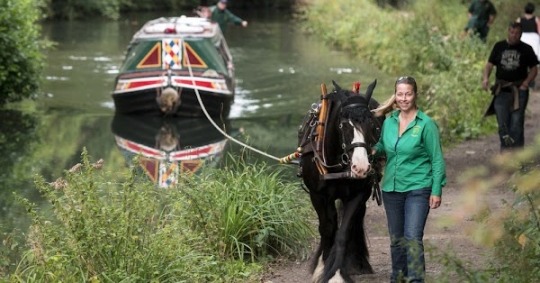
Later, engines were developed.
Even after the trains won the arms race, it was a fairly viable freight service right up until WW2. It’s slow travel, but uses few resources and requires little human power, with a fairly small crew (of women, in WW2) being capable of shifting two fully laden boats without consuming much fossil fuel.
In those times the barges were designed with small, cramped cabins in which the boaters and their families could live.
During its heyday the narrowboat community developed a style of folk art called “roses and castles” with clear links to fairground art as well as Romani caravan decor. They are historically decorated with different kinds of brass ornaments, and inside the cabins could also be distinctively painted and decorated.
Today, many narrowboats are distinctively decorated and colorful - even if not directly traditional with “roses and castles” they’ll still be bright and offbeat. A quirky name is necessary. All narrowboats, being boats, are female.
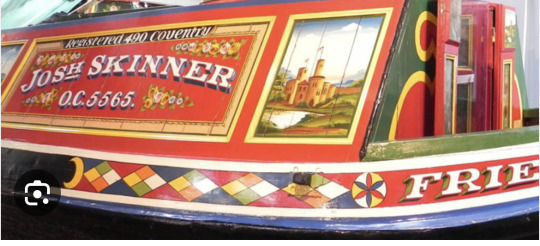

After a postwar decline, interest in the waterways was sparked by a leisure movement and collapsing canals were repaired. Today, the towpaths are a convenient walking/biking trail for people, as they connect up a lot of the mainland of the UK, hitting towns and cities. Although the restored canals are concrete-bottomed, they’re attractive to wildlife. Narrowboats from the 1970s onward started being designed for pleasure and long-term living. People enjoy vacationing by hiring a boat and visiting towns for a cuter, comfier, slower version of a campervan life. And a liveaboard community sprang up - people who live full-time on boats. Up until the very restrictive and nasty laws recently passed in the UK to make it harder for travelling peoples (these were aimed nastily at vanlivers and the Romani, and successfully hit everyone) this was one of the few legal ways remaining to be a total nomad in the UK.
Liveaboards can moor up anywhere along the canal for 28 days, but have to keep moving every 28 days. (Although sorting out the toilet and loading up with fresh water means that a lot of people move more frequently than that.) you can also live full-time in a marina if they allow it, or purchase your own mooring. In London, where canal boats are one of the few remaining cheapish ways to live, boats with moorings fetch the same prices as houses. It can be very very hard for families to balance school, parking, work, and all the difficulties of living off-grid- but many make it work. It remains a diverse community and is even growing, due to housing pressures in the UK. Boats can be very comfortable, even when only six feet wide. When faced with spending thousands of pounds on rent OR mooring up on a nice canal, you can see why it seems a romantic proposition for young people, and UK television channels always have slice-of-life documentaries about young folks fixing up their very own quirky solar-powered narrowboat. I don’t hate; I did it myself.
If you’re lucky, you might even meet some of the cool folks who run businesses from their narrowboats: canal-side walkers enjoy bookshops, vegan bakeries, ice-cream boats, restaurants, artists and crafters. There are Floating Markets and narrowboat festivals. It’s generally recognised that boaters contribute quite a lot to the canal - yet there are many tensions between different kinds of boaters (liveaboards vs leisure boaters vs tourists) as well as tensions with local settled people, towpath users like cyclists, and fishermen. I could go on and on explaining this rich culture and dramas, but I won’t.


Phillip Pullman’s Gyptians are a commonly cited example of liveaboards - although they were based on the narrowboat liveaboards that Pullman knew in Oxford, their boats are actually Dutch barges. Dutch barges make good homes but are too wide to access most of the midlands and northern canals, and are usually restricted to the south of the UK. So they’re accurate for Bristol/London/Oxford, and barges are definitely comfier to film on. (Being six feet wide is definitely super awkward for a boat.) but in general Dutch barges are less common, more expensive and can’t navigate the whole system.

However, apart from them, there are few examples of narrowboat depictions that escaped containment. So it’s quite interesting that there is an entire indigenous special class of boat, distinctive and highly specialised and very cute, with an associated culture and heritage and folk art type, known to all and widely celebrated, and ABSOLUTELY UNKNOWN outside of the UK - a nation largely known around the world for inflicting its culture on others. They’re a strange, sweet little secret - and nobody who has ever loved one can resist pointing them out for the rest of their lives, or talking about them when asked to. Thank you for asking me to.
6K notes
·
View notes
Text
Traintober 2023: Day 27 - Record-Breaker
Mallard Broke the World Speed Record; It Broke Her:

4468 Mallard broke the world steam speed record in 1938, changing her life forever…
1938:
The quiet, almost timid engine sat in the works, listening to the workers.
“You hear? That engine there is fastest in the world!” one said, pointing to the famous engine. Mallard blinked, amazed. She’d never been told if she’d actually broken the record – but to hear that she had, and to hear that it was major news! It was incredible.
There was no one better than her in that moment – she was the greatest!
“Ah, the engine of the hour!” cheered a voice. Mallard gazed down, spotting Sir Nigel Gresley himself walking over. Mallard gasped in amazement. The Chief Mechanical Engineer almost never visited his engines. “I came to congratulate you again, Mallard. I am proud of you – you are truly a credit to this railway. The poster child for what every Northeaster engine should strive for. Well done, and keep up the good work, Mallard.”
Mallard beamed, thanking her designer. Then, she turned to the gossiping workers.
“Well? You heard him – I need to be back in service now! Hurry it up!”
1963:
“So, which of us is to be preserved?” asked Silver Link, staring down apprehensively at the members of the British Railways board. The men had come to decide on a Gresley Pacific to save from the scrapper’s torch.
“Who do you think?” snorted one of the men in the bowler hats. “We must choose the locomotive that achieved the greatest feat of a steam locomotive – 60022 Mallard, you are to be restored to your LNER looks and sent to the Museum of British Transport Museum. The rest of you… hope someone purchases you.”
Silver Link just stared in shock as several diesels sniggered in the background.
“But I… but… She didn’t even make it back to London! I am the first! I reached 114—”
“Stop speaking 60014, there is no reason for you to complain. You are already withdrawn, and shall be sent away once we have the time.”
“Mallard… are you going to allow this?” asked Silver Link, eyes wide in horror.
“Well, elder sister, some of us are just… more important than others. I represent our class, and I am the best at such an honour.” Silver Link went red in the face, but Mallard was already steaming away, blowing smoke at her elder sister.
Behind Silver Link, Flying Scotsman and Silver King shared a nervous look.
1975:
Flying Scotsman sat on the points outside the brand new York National Railway Museum, Green Arrow on one side and Gordon on the other. It was the first time that the four had seen each other – the fourth being an indignant Mallard sat opposite them.
“What do you mean, he’s worthy of being the same level as me?” sniffed Mallard. “He’s a mixed traffic engine!”
“Green Arrow is an LNER engine, same as us,” reminded Scott crossly, facing down his cousin. “And there are only nine LNER Pacifics left, so your levels are completely worthless! We need to end this… this… this…”
“Elitist garbage!” Gordon snapped. “We are long past this, cousin. What’s stopping you from accepting Green Arrow?”
“Green Arrow is a simple mixed traffic engine,” hissed Mallard. “I am the greatest steam engine to have ever been built! No one has ever, or will ever, beat my record. There’s a reason that I am in this museum, and you are out slaving away to keep in steam.”
“Slaving away?!” Gordon let off steam furiously. Scott just clenched his jaw.
“There’s no point arguing with her,” he sighed. “We’re better off just getting the rest on side.” The three steamed away, leaving Mallard to be pushed gently back into the grand museum by a timid diesel shunter.
None of the other engines in the museum spoke to her as she was shunted into place. Not Evening Star, not Aerolite, not Coppernob. They all just shot her dark glances.
1988:
Mallard sped along the line, feeling the wind rush past her face.
“I forgot what this was like,” she huffed, finally arriving back at Doncaster after crossing the country to reach Scarborough and back. Several relatives of her crew from back when she’d broken the world record sat in her coaches – but they were inconsequential. After all, any crew could have gotten her up to her record-breaking speed.
“So, how was the run?” asked Gordon politely, sitting in the next platform over. Mallard ignored him. Gordon rolled his eyes. Green Arrow and Spencer shared a look.
“I’m impressed,” hummed Spencer. “Though I’ve heard that the East Germans have built a steam locomotive that’s almost able to match Mallard’s speed.” Mallard’s eye twitched.
“No they haven’t!” she suddenly snarled, spooking several of the passengers on the platform. “I am the fastest. That’s my role! Don’t talk such drivel around me.”
Spencer sighed. As the only one of Mallard’s siblings willing to speak to her, and one of only four engines that had spoken to Mallard (he’d checked with Duchess of Hamilton) in the last ten years, he was uniquely able to see just how much his younger sister had changed.
Where Mallard had once been a healthy pale, her pallor had grown almost dangerously blue – while her formerly vibrant eyes had gone dull, with just a hint of something… unsettling in them. And yet her paintwork was spotless, her brass polished until it glistened in the sun, even after a full run with passengers.
“Are you alright?” asked Spencer quietly. Gordon and Green Arrow pretended not to hear.
“I beg your pardon?!” roared Mallard, spooking yet more passengers. “Are you insinuating something?! That such a simple run would tire me out? I am the fastest steam engine in the world – I am more than competent, thank you.”
“I just wanted to ch—”
“Well don’t!” sneered Mallard. “I am fine.”
Spencer’s tentative frown turned downwards into a scowl, and the great silver engine hissed steam as he started away. Gordon watched him go, knowing deep in the pit of his boiler that the silver engine wouldn’t be back.
Silver King had never truly forgiven his younger sister for the way she’d spoken to Silver Link, even if his name had changed, as had his owners and his lifestyle.
2013:
Spencer, Bittern, Dominion of Canada, Dwight D Eisenhower, Union of South Africa, and Sir Nigel Gresley all stood in awkward silence. Their sister – Mallard – was being wheeled out of the museum for a photoshoot.
“So… did you hear her last night?” asked Dwight quietly. “She was screaming at the shunting diesels again.”
“I can’t believe they made me agree to his,” hissed Spencer. “I promised myself after 1988 – never again. And yet here I am. At least Scott gets to hide in the workshops.”
“It cannot be that bad?” tried Woodcock – only the humans called her Dominion of Canada, “I mean… she has to have made some friends in there, right?”
“Unlikely,” snorted Osprey – the humans had given her that name in the 1980s, and she much preferred it to ‘Union of South Africa’, “she spends most of her days just glaring at everyone. Last I heard, it’s a real treat for them when she gets brought out here to be gawked at.”
“Shh! Shh! She’s coming,” warned Bittern. The six all went silent as Mallard was dragged off the turntable and over to the line of engines.
“Ah, good, you all made it,” Mallard said haughtily. “It’s what I deserve, getting the humans to bring you all here to celebrate our class’s greatest achievement.”
“What you—” Osprey cut off, indignant. Beyond her, Dwight gawked in shock while Spencer just rolled his eyes. The shunter braked the famous engine to a stop, jolting slightly.
“Did you just jolt me?” hissed Mallard, voice deathly quiet. The shunter gulped.
“Don’t you dare!” snapped Spencer, speaking to the world-record holder for the first time in nearly thirty years. “You cannot deride these hard-working engines, I refuse to allow it!”
“Oh? As if you are any better, Mr Private Engine,” sneered Mallard. “Silver King, the weird runt of the class who galivants off to that backwards island where our Crewe-rebuilt cousin lives.”
“Gordon still pulls his express!” roared Spencer, letting off steam furiously. “Gordon treats everyone with respect! He’s a far better representative of our railway than you are – he’s out there, pulling passengers and acting as the ambassador for Gresley’s work. He holds a record for the longest-serving express engine in the world!”
“He has Midland parts,” snarled Mallard. “He’s a mongrel of parts, and I can’t stand him! I can’t stand him and his righteousness! This is my celebration, my record, my museum! He can talk when he has a proper record of his own. Let’s see him try and beat me – oh wait, didn’t he lose his dome last time he attempted that?”
None of the other A4s spoke, and the moment the photoshoot was over, all four in steam left, taking Dwight and Woodcock with them, leaving Mallard alone.
2016:
Flying Scotsman sat outside the NRM, steam wafting from his funnel. He was the last one left. Spencer had permanently relocated to Sodor after 2013, the other A4s steered clear of York Museum, Gordon had his own work, and Green Arrow had moved to Shildon. So, it was only him left to talk to her.
“Oh, it’s the money pit.”
“Mallard. I came to say goodbye.”
“Goodbye? Where are you going, Gresley Disgrace?”
“I’m going to run mainline excursions,” Flying Scotsman replied evenly. “I’m not going to have to listen to you anymore when you scream abuse at the others or rant about the new PRR engine.”
“Rant? Abuse? 4472, you don’t understand! I am Gresley’s pride and joy! I am the greatest – he would roll over in his grave if he saw you now. It’s my destiny to be the greatest – and everyone needs to accept that!”
“Sir Nigel Gresley loved us all equally,” snapped Flying Scotsman. “And don’t you forget, any one of your class—”
“I did it!” roared Mallard. “Me! Not any of you! I am the world record breaker – I am the greatest steam engine of all time! You’re nothing compared to me! I am Sir Nigel’s triumph! I am the legacy of the Northeasters! Me! How dare you speed to me like that?! Learn your place!”
Flying Scotsman stared evenly back at the shrieking engine.
“I have,” he said simply. “And it’s not here. The other engines can survive listening to your abuse, but I don’t have to. You’re nothing, Mallard. Not anymore. You sit here, on this siding, in this shed, and you cling to the past because that’s all you’ll ever have.”
Flying Scotsman puffed out of the shed, the wrecked screams of his cousin following him through the sliding shed doors. They transformed from howls of rage into a hail of screeching tears, as Mallard’s entire self-worth crashed down on her. The former icon of steam and speed finally lost it, all the rage and anger and simmering hatred growing inside her frames boiling over as she cursed her cousin.
Flying Scotsman couldn’t help but feel sorry for the engine – but all the same, she had spent decades wrecking their designer’s good name with her attitude. Her stardom had placed her up on a pedestal – one where the loneliness of fame had engulfed her.
Back to Master Post
#fanfiction writer#railway series#weirdowithaquill#thomas the tank engine#railways#traintober 2023#traintober#ttte mallard#ttte flying scotsman#ttte green arrow#ttte spencer#ttte gordon#mental problems#Mallard loses her humanity
63 notes
·
View notes
Text
Happy Mallard Day!
Most people in my country will be celebrating tomorrow, July 4th. I’m a bit unusual for an American in that I’m always more excited for July 3rd, because a remarkable feat of engineering history happened that day in 1938 (in multiple senses of the word). Today I’m going to tell the story of a locomotive named for a duck.
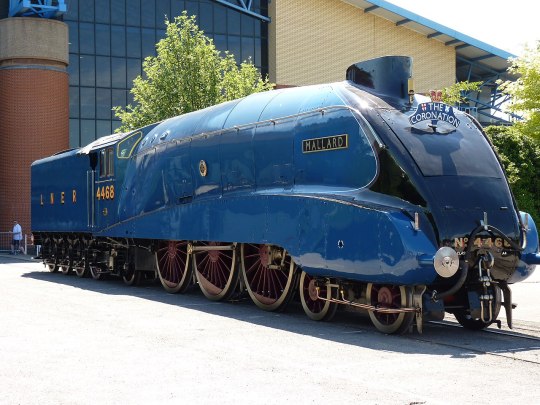
(Image: 4468 Mallard, a streamlined 4-6-2 Pacific locomotive, sitting pretty in York, England, United Kingdom. She is painted bright blue with red wheel spokes.)
The story begins well before July 3rd, 1938, of course - mechanical engineer Sir Nigel Gresley was well established in his position as the CME of the London and North Eastern Railway by that date. In 1923, his most famous creation, a 4-6-2 Pacific A1 numbered 4472, took to the rails for the first time. Originally numbered 1472, within a year of running between London to Edinburgh she received her more familiar 4472 after the LNER finally settled on a company-wide numbering scheme - and the name she’d be best known under, Flying Scotsman. She became the company’s flagship locomotive and solidified Gresley’s ability to design Pacifics in the mind of the public.
Her most important contribution to what I’m about to get into the meat of here, though, occurred on November 30th, 1934. On that date, pulling a light testing train behind her, Flying Scotsman hit 100 mph, becoming the first locomotive to hit that speed whilst being officially measured. Other locomotives may have reached 100 mph before, most notably GWR 3700 City of Truro and NYC 999, but this was the first time the speed was officially recorded, and so Scotsman got her name into the record books.
Dating back to the 19th century, railroads in Great Britain competed against each other in what was known as the Race to the North, in which they actively attempted to outdo each other and get passengers from the south, usually London, up to various destinations in Scotland. Nobody ever actually said they were racing, of course, but in retrospect it was pretty obvious what was going on as the railroads introduced faster and faster services. By the 1930s, the railroads had been consolidated into four companies - the Big Four (the Great Western, the Southern, the London, Midland and Scottish, and the heroes of this story, the London and North Eastern). The LMS controlled the West Coast Main Line, and the LNER controlled the East Coast Main Line. (This is important.) In 1927, the LNER started running the named train Flying Scotsman non-stop from London to Edinburgh, utilizing corridor tenders to perform crew changes at speed without stopping. Not to be outdone, the LMS beat them to the punch, running non-stop services between London and Glasgow and London and Edinburgh on their own, and it was officially on. Although speeds were still within a reasonable range at this point, both railroads knew they needed to go faster, and Sir Nigel Gresley looked to Germany.
In Germany, a new streamlined service called the Flying Hamburger had been introduced. This was a diesel train set that ran between Hamburg and Berlin at remarkably high speeds - it had an average speed of 77 mph and could hit around 99-100 mph at its maximum. For regular service, this was impressive, and Gresley wondered if the same could be done using steam power. He knew streamlining was the key, but the LNER knew that the diesels in Germany didn’t have the same passenger capacity as their steam locomotives could pull in carriages, so he needed to get creative. He looked to Bugatti for inspiration; their racecars, in their resplendent blue, were but one thing the car company was working on - they were making streamlined railcars, as well. Gresley took note of their designs, and his new locomotives would eventually pay homage by being colored Bugatti blue.
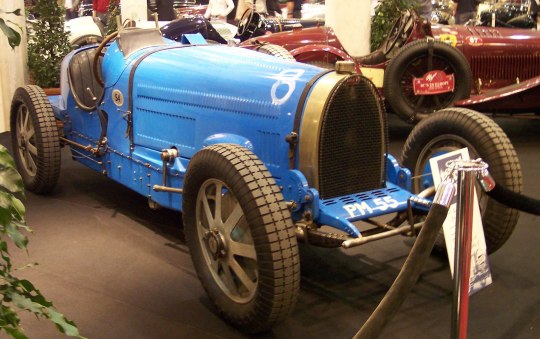
(Image: a Bugatti Type 54 racecar, painted in a vivid blue.)
By the time Flying Scotsman hit 100 mph in 1934 and another Gresley Pacific locomotive, A3 2750 Papyrus, managed to hit a whopping 108 mph without streamlining, the LNER knew that Gresley was capable of the task, and they allowed him to design a streamlined locomotive. Gresley set to work making improvements to his A3 design, and the first four A4s were born.

(Image: an unidentified A4 Pacific locomotive.)
The A4s were fast, hitting 112 mph on the inaugural run of the Silver Jubilee service between London and Newcastle in 1935. Gresley, of course, was not satisfied - he knew he could still improve his design, and at any rate, his competition over at the LMS was going to be trying to catch him. He went back to the drawing board to make the A4s even better.
As this was going on, the LMS was indeed playing catchup, and they introduced their beautiful Coronation class locomotives, designed to pull the Coronation Scot starting in 1937. The first several of them were streamlined in gorgeous, bright casings, and they caused a stir, taking the British speed record back at 114 mph in an attempt by 6220 Coronation that ended with a sudden braking and a whole lot of kitchenware being flung every which way in the dining car. Engineer/driver T.J. Clark and fireman C. Lewis kept her under control, but the passengers were not amused, and speed records were shelved for the time being...until, once again, Germany entered the fray.
Back in 1936, a German locomotive, the DRG Class 05, set a land speed record for steam, hitting 124.5 mph. Gresley was aware of this and had it in the back of his mind as he improved his A4s. He experimented with giving some of them a Kylchap exhaust system, an innovation developed by French locomotive designer André Chapelon after the work of Finnish engineer Kyösti Kylälä. Chapelon’s work went woefully under-acknowledged, but Gresley paid attention and appreciated his work, and it would pay off. Wind tunnel tests proved a bit frustrating at first until a fortuitous accidental thumbprint helped to move the smoke up and over the locomotive instead of in the crew’s faces, and the stage was set.
4468 Mallard rolled off the line at Doncaster Works on March 3rd, 1938, her name derived from Gresley’s love of breeding waterfowl. Indeed, many of her sibling locomotives were also named for birds, like 4464 Bittern, 4467 Wild Swan, 4902 Seagull, and 4903 Peregrine, but the duck was about to steal the show. Mallard spent the next few months getting used to working and being broken in so she wasn’t brand new, and on the day she turned four months old, it was time to make history.
Mallard’s driver that day was a 61-year-old grandfather named Joe Duddington. As a locomotive engineer, he was experienced and knew how to take calculated risks, and so he’d been assigned to pilot her. With him on the footplate was fireman Tommy Bray and his massive tattooed arms, ready to keep Mallard fed as they drove into the history books. They were performing a “brake test” that day, or so the LNER told most people, passengers included, but Joe and Tommy knew what was actually going on. In the cab with them was an LNER official, Inspector Jenkins, and attached to the train behind the tender was a dynamometer car, there to record Mallard’s speed throughout her run. Since this was an alleged “brake test” the dynamometer car didn’t raise any eyebrows right away. Gresley himself unfortunately wasn’t in the best health that day and was unable to be present himself, but there were enough LNER officials on hand to see to it that everything ran smoothly. Mallard was fitted with a stink bomb of sorts of aniseed in case the big end bearing for the middle of her three cylinders overheated, as the A4s had previously had difficulty with this, and she set out heading northwards. The return trip was where everything was going to get serious.
Upon turning around to return south to King’s Cross, passengers were finally informed of what was going to happen and were given the opportunity to disembark and take another train if they were worried, especially given what had happened during the LMS record attempt a year prior. Everyone agreed to stay on board. Joe Duddington turned his hat backwards, a reference to George Formby’s character in the film No Limit, and opened the throttle.
Mallard slid back onto the main line, headed towards Grantham, where the speed-up was to begin. Unfortunately, work on the track limited her to only 15 mph at this stage, and Joe Duddington got her through the Grantham station at only 24 mph instead of the 60-70 mph she should have been at. Nevertheless, she began to build up more and more speed as she climbed up Stoke Bank, and Duddington had her at a solid 85 mph at the summit.
“Once over the top, I gave Mallard her head, and she just jumped to it like a live thing,” Duddington recounted later in an interview. Her speed rapidly increased, and she was soon hitting 110 mph, at which point he told her, “Go on, old girl, we can do better than this!” Mallard responded, and by the time she was flying through a village called Little Bytham, a blur of blue paint and pumping rods and flying ash, she had well exceeded the LMS record and was even with the German DRG Class 05. The needle in the dynamometer car tipped up higher and higher and surpassed the Class 05 by slipping up to 125 mph...then, for about a quarter of a mile, reached even higher, at 126 mph. She’d done it.
Mallard had to slow down soon after because of a junction, but Joe Duddington and Tommy Bray were sure she could have gone faster had they not had to slow for construction - they believed she was capable of 130. The big end bearing did overheat, and Mallard was detached from the train at Peterborough and brought back to Doncaster to be fixed up, but not before one of the most famous photos in railroad history was taken:
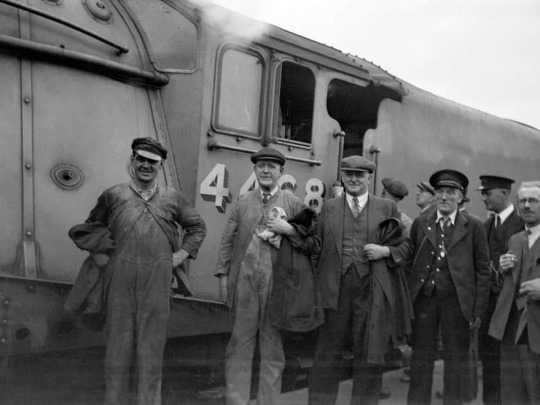
(Image: the crew poses in front of Mallard, a 4-6-2 Pacific locomotive numbered 4468, immediately after setting the speed record. L-R: Tommy Bray [fireman], Joe Duddington [driver/engineer], Inspector Jenkins, Henry Croucher [guard/conductor]. Joe Duddington has turned his hat around to face the correct way again after having it on backwards during the record run. Photo credit: National Railway Museum.)
Joe Duddington actually stayed on a bit past his retirement age to help free up soldiers for the war effort. When he finally retired, on his final day of work, he drove Mallard one last time.
Sir Nigel Gresley himself never accepted the brief stint at 126 mph, instead saying his locomotive set the speed record at 125 mph. But history has accepted the 126 mph as the true top speed, given that Mallard was possibly capable of even more, and today she has plaques on her streamlined cladding to commemorate her feat. A second record attempt was planned to see if she could go even faster, but World War II broke out and the idea was scrapped.
undefined
youtube
Tommy Bray eventually got on the throttle himself, fulfilling his own dreams. Both men are honored in a cemetery in Doncaster with a new memorial headstone for Duddington featuring Mallard on it.
As for Mallard herself, she continued working until April 25th, 1963, at which point she’d clocked nearly a million and a half miles in service. She was pulled for preservation for obvious reasons, and today she lives at the National Railway Museum in York, along with her dynamometer car that recorded her history-setting run. Five of her A4 siblings also survive, and a few of them are operational to this day, including the one named for her designer, Sir Nigel Gresley. Of all of his ‘birds,’ the one that flew fastest was the humble duck.
For more on Mallard and her creator Gresley, here are a few resources:
Mallard: How the Blue Streak Broke the World Speed Record by Don Hale is a great book on the subject that I enjoyed thoroughly. It does have a Kindle edition if you’d prefer an ebook variation, as well, and most major book retailers carry it on their websites.
The National Railway Museum, Mallard’s retirement home, has a 3D experience/ride of sorts that simulates what it was like to be running with her that day, the video of which is online here. Note the music, which mirrors her three cylinders pumping away. The video isn’t able to be embedded, but you can watch it here. There’s also a child-friendly version, too.
Lastly, the appropriately named prog rock band Big Big Train did a song about Mallard called East Coast Racer, which regularly moves me to tears because this locomotive means so much to me and they tell her story so lovingly.
undefined
youtube
I actually recommend checking out the live version, too, because they show the photo of the crew at the end and every single time I start sobbing.
If you want to visit the old girl herself, she’s at the National Railway Museum in York in the UK, and they have a ton of amazing resources and incredible locomotives and rolling stock in their collection. I’d highly recommend checking them out if you can!
Happy Mallard Day, everyone. Fly far, fly fast, make history.
#LNER Mallard#LNER 4468 Mallard#LNER#LNER A4#I like trains#I spent literal hours on this whoops#but she's really important to me
50 notes
·
View notes
Text
The engines as different basis (EoSR but built different) - 1
(Tender engines as tank engines, vice versa)
From No. 1 - 6 (Thomas, Edward, Emily, Henry, Gordon, James)
NWR 1 Thomas (formerly LBSCR 307, SR 2307)

Class: London, Brighton, and South Coast Railway (LBSCR) Class C3 Horsham Goods
Previous Owners: London, Brighton, and South Coast Railway; Southern Railway; British Railways (Southern Region)
Built: August 1906
Real-life Withdrawal: May 1949 (never received a BR number)
Designer: Douglas Earle Marsh
Builder: Brighton Works
Bio:
Thomas is the first tender engine purchased by the NWR, after the withdrawals of the original NWR 1 - 6 (the last one being in 1925). The NWR had believed that they wouldn't need any tender engine power until the withdrawal of NWR 1 in 1925.
NWR 2 Edward (formerly W&SR 5)

Class: Dublin, Wicklow and Wexford Railway (DW&WR) 52 class; North Western Railway (NWR) Class S-W52
Previous Owners: Wellsworth & Suddery Railway
Built: 1893
Real-life Withdrawal: n/a
Designer: William Wakefield
Builder: Sharp, Stewart and Company (Glasgow, Scotland)
Bio:
Edward was commissioned by the Wellsworth and Suddery Railway. His design was altered so that he could run on standard gauge rails. When the merger occured, he was passed down to the NWR, along with Emily, and the NWR attempted to rebuild him so he could handle the new jobs. This did not work out, resulting in Edward having poor steaming issues. He was swapped with Emily, working lighter and fewer jobs.
NWR 3 Emily (formerly GNR 1009 and W&SR 6)



Class: Great Northern Railway (GNR) Class H1 Stirling Tank; North Western Railway (NWR) Class S-S1 Stirling Tank
Basis (Inspiration): GNR Stirling Single A3, GNR G1, and B&ER 4-2-4 tank engines
Previous Owners: Great Northern Railway; Wellsworth and Suddery Railway
Built: 1882
Real-life Withdrawal: n/a
Designer: Patrick Stirling
Builder: Doncaster Works
Bio:
Emily is an experimental tank engine version of the GNR A1, A2, and A3 Stirling Singles, with a wheel config of 4-2-4T. While she did perform decently, she did not perform as they expected so she was withdrawn. The Wellsworth and Suddery Railway took interest in Emily. They purchased her from the GNR before she could be sold to a scrapyard. She worked welled on the W&SR, able to be passed down to the NWR in 1915, along with Edward. She ended up replacing Edward on the express passenger service when the latter's rebuilds proved to worsen his performance.
NWR 4 Henry




Class: North Eastern Railway (NER) Class F; North Western Railway (NWR) Class S-S5 (4-6-4T) Black Five Tank
Basis (Inspiration): NER Class D (pre-1935); LNER Class A2 (pre-1935); LMS Class 5MT Black Fives (post-1935); LMS 4MT 2-6-4T (two-cylinder) (post-1935)
Previous Owners: Unknown
Built: 1920
Real-life Withdrawal: n/a
Designer: Vincent Raven; Henry Stanier
Builder: Unknown
Bio:
Henry was built from stolen duplicates of Vincent Raven's plans of a 4-6-2T, which were derived from the NER Class D (4-4-4T). Unfortunately, these duplicate plans were the discarded designs due to uneven weights on the chassis and the use of a Schmidt boiler. He was under-powered and a hazard to operate. Sir Louis Topham Hatt I was swindled to buy Henry in 1922 when promised that Henry would be the next best thing for railways. This was when the NWR believed that they wouldn't need tender engines to run the railway.
After the Flying Kipper crash, Henry was rebuilt into a new class of his own, the LMS Class 5MT Black Five Tank.
NWR 5 Gordon
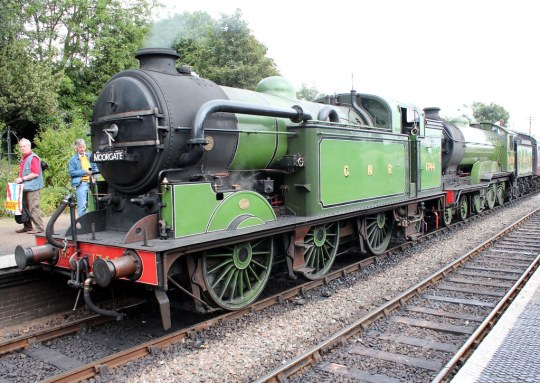
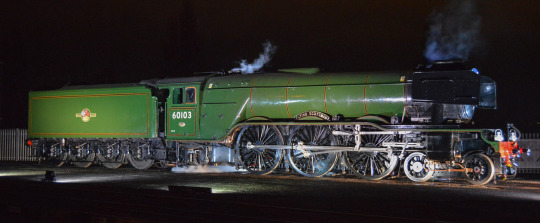
Class: Great Northern Railway (GNR) Class B1; North Western Railway (NWR) Class S-G1
Basis (Inspiration): GNR Gresley Class A1, GNR Gresley Class A3, and GNR Gresley Class N2
Previous Owners: Great Northern Railway
Built: 1920 - 1923
Real-life Withdrawal: n/a
Designer: Nigel Gresley
Builder: Doncaster Works
Bio:
Gordon is an experimental tank version of the GNR Gresley A1s, in hopes of surpassing the capabilities of the Gresley N2s. This did not work out but served as a basis for the LNER V1s. He was sold off to the NWR, replacing Emily on heavy passenger duty, which was the express service for the NWR.
NWR 6 James (formerly L&YR 506, LMS 11546)

Class: Lancashire and Yorkshire Railway (L&YR) Class 24; NWR Class S-A25
Previous Owners: L&YR, LNWR, LMS
Built: 1919
Real-life Withdrawal: 1959 (BR number would've been 51546)
Designer: John Audley Frederick Aspinall
Builder: Horwich Works
Bio:
James was bought as he was originally built in 1925. However, Sir Bertram Topham Hatt II ordered for James to be rebuilt into a 2-6-2T. This took well over a few months until they finally came up with a decent design. Unfortunately, James' great performance came at the cost of James' loosing his memories.
#eosr but built different#ttte thomas#ttte edward#ttte emily#ttte henry#ttte gordon#ttte james#her train of thoughts#''what if'' AUs are so fun
9 notes
·
View notes
Text
Find a Residential Structural Engineer near You
Seeking a residential structural engineer nearby? Our team offers expertise in ensuring the stability and safety of your home projects. From renovations to new constructions, we provide personalized solutions tailored to your location. Trust our experienced professionals for reliable structural assessments and recommendations. Reach out today to find a residential structural engineer near you.
Visit Here: https://www.cadengineeringsolutions.co.uk/for-structural-engineers.php
#architectural design solutions#residential structural engineer near me#structural engineering company#structural engineering for architects#structural engineer london#structural steelwork fabricators#structural steel detailing services#top structural engineering firms uk
0 notes
Text
Best MEP Engineering Services in London, United Kingdom

Silicon EC UK Limited offers comprehensive MEP Engineering Services in London, United Kingdom, catering to a diverse range of construction projects. With a commitment to excellence and innovation, we provide integrated solutions that ensure optimal performance, sustainability, and cost-efficiency for our clients. Our Engineering Crafts of skilled engineers bring a wealth of experience and expertise to every project, employing the latest technologies and industry best practices to deliver exceptional results.
By choosing Silicon EC UK Limited for MEP Shop Drawing Services, clients can expect timely delivery, cost-effectiveness, and unparalleled expertise. We are committed to providing reliable support throughout the construction process, helping clients bring their projects to fruition with precision and efficiency.
For More Details Visit our Website:
#MEPF Shop Drawing Service#MEPF Shop Drawing projects#MEPF Engineers#MEPF Shop Drawing#Shop Drawing#MEPF Structure#MEPF Shop Drawings#MEPF Engineering Service#Outsourcing MEP Shop Drawings#MEP Shop Drawing Outsourcing Services#MEP Shop Drawing Service Provider#MEP Engineering Company London#MEP Engineering Services London#MEP Engineering Firm London#CAD Design#CAD Drawing#CAD Drafting#Engineering Company
0 notes
Text
GMS Company in UAE - Keyword research is how the words typed into the search box of Google, Yahoo, Bing, or any other search engine are ranked.

Introduction
Welcome to our article on keyword research and search engine optimization (SEO) techniques for GMS Company in UAE. In today's digital world, having a strong online presence is essential for businesses to thrive. One of the key factors in improving your online visibility is understanding how search engines work and optimizing your website accordingly. In this article, we will explore the importance of keyword research and discuss effective SEO strategies to achieve higher search engine rankings in the UAE market.
Search Engine Algorithms
Search engine algorithms play a vital role in determining how websites are ranked in search results. These algorithms are complex sets of rules that search engines use to analyze and evaluate websites. Understanding how these algorithms work can give businesses a competitive edge in the online marketplace.
Search engines like Google, Yahoo, Bing, and others use various factors to determine the relevance and ranking of a website. These factors include keyword usage, website structure, user experience, backlinks, and many others. By optimizing your website based on these factors, you can improve your chances of appearing higher in search results.
Search Engine Rankings
Having a high search engine ranking is crucial for attracting organic traffic to your website. When users search for relevant keywords related to your business, appearing on the first page of search results significantly increases your chances of getting clicks and potential customers.
However, achieving a top position in search engine rankings requires consistent effort and optimization. It's important to keep in mind that search engine algorithms are constantly evolving, so staying up-to-date with the latest SEO strategies is crucial.
UAE Market Analysis
Before diving into keyword research and SEO techniques, it's essential to conduct thorough market analysis for the UAE region. Understanding the local market trends and consumer behavior will help you tailor your SEO strategies to target the right audience effectively.
The UAE market is known for its diversity and rapid growth. With a tech-savvy population and a strong emphasis on digital innovation, businesses need to align their SEO efforts with the specific needs and preferences of the UAE market.
Keyword Research Techniques
Keyword research is the foundation of any successful SEO campaign. It involves identifying the most relevant keywords and phrases that your target audience is likely to use when searching for products or services similar to yours.
There are several keyword research techniques you can employ to find the right keywords for your business:
Brainstorming: Start by brainstorming a list of words and phrases that are relevant to your business. Think about the products or services you offer and how your target audience might search for them.
Competitor Analysis: Analyze the keywords your competitors are targeting. Tools like SEMrush and Ahrefs can help you identify the keywords for which your competitors are ranking.
Google Autocomplete: Use Google's autocomplete feature to discover additional keywords related to your industry. Simply start typing a word or phrase in the search box, and Google will suggest popular queries.
Long-tail Keywords: Long-tail keywords are longer and more specific phrases that have lower search volumes but higher conversion rates. Include long-tail keywords in your research to target a more focused audience.
Keyword Research Tools: Utilize keyword research tools like Google Keyword Planner, Moz Keyword Explorer, or Ubersuggest to get insights into keyword search volumes, competition, and related keywords.
SEO Strategies
Once you have identified the most relevant keywords, it's time to implement effective SEO strategies to optimize your website for search engines. Here are some key strategies to consider:
On-Page Optimization: Optimize your website's content, meta tags, headings, and URLs using the identified keywords. Ensure that your content is relevant, informative, and engaging for both users and search engines.
Mobile-Friendly Design: In today's mobile-dominated world, having a mobile-friendly website is crucial. Ensure that your website is responsive and provides a seamless user experience across all devices.
Quality Link Building: Building high-quality backlinks from reputable websites can significantly boost your search engine rankings. Focus on acquiring natural, relevant, and authoritative links pointing to your website.
Site Speed Optimization: Website speed is an important factor in search engine rankings. Ensure that your website loads quickly by optimizing images, minimizing code, and leveraging caching techniques.
Technical SEO: Pay attention to technical aspects such as site structure, XML sitemaps, robots.txt, and schema markup. These elements help search engines understand your website better and improve its visibility.
User Experience: Provide a seamless and intuitive user experience on your website. Make it easy for visitors to navigate, find information, and engage with your content. Search engines value positive user experiences.
Remember that SEO is an ongoing process that requires continuous monitoring, analysis, and optimization. Stay updated with the latest SEO trends and adapt your strategies accordingly to maximize your organic search visibility in the UAE market.
Conclusion
Keyword research and SEO techniques are essential for improving your GMS Company's online visibility in the UAE market. By understanding how search engine algorithms work and implementing effective SEO strategies, you can achieve higher search engine rankings and attract more organic traffic to your website. Remember to conduct thorough market analysis, identify relevant keywords, and optimize your website based on the latest SEO best practices. With consistent effort and continuous optimization, you can stay ahead of the competition and establish a strong online presence for your GMS Company in the UAE.
FAQ - GMS Company in UAE: Keyword Research and SEO Techniques
What is keyword research, and why is it important for a GMS Company in the UAE?
Keyword research involves identifying relevant words and phrases used in search engines. It's crucial for GMS Companies in the UAE to improve online visibility by understanding how potential customers search for products or services.
How do search engine algorithms impact the ranking of a website?
Search engine algorithms are sets of rules used to analyze and rank websites. Understanding these algorithms helps businesses optimize their websites for factors such as keyword usage, user experience, and backlinks, influencing search engine rankings.
Why is a high search engine ranking important for businesses in the UAE market?
A high search engine ranking increases the visibility of a GMS Company's website, attracting organic traffic. Appearing on the first page of search results enhances the chances of clicks and potential customer acquisition.
What factors should be considered in the UAE market analysis for SEO?
Thorough market analysis involves understanding local trends and consumer behavior in the UAE. This includes recognizing the diversity, tech-savviness, and rapid growth in the market.
What are the key techniques for effective keyword research?Techniques include brainstorming relevant terms, competitor analysis, using Google Autocomplete, incorporating long-tail keywords, and utilizing keyword research tools like Google Keyword Planner and Moz Keyword Explorer.
What are the key SEO strategies for optimizing a GMS Company's website?|
Key strategies include on-page optimization, mobile-friendly design, quality link building, site speed optimization, technical SEO considerations, and prioritizing a positive user experience.
Why is on-page optimization crucial for SEO, and what elements should be optimized?
On-page optimization involves optimizing content, meta tags, headings, and URLs using identified keywords. Relevant, informative, and engaging content contributes to both user satisfaction and search engine rankings.
How does a mobile-friendly design contribute to SEO success?
A mobile-friendly website ensures a seamless user experience across devices. Given the prevalence of mobile usage, a responsive design is crucial for improving search engine rankings and user satisfaction.
What role does quality link building play in boosting search engine rankings?
Quality link building involves acquiring natural, relevant, and authoritative backlinks from reputable websites. These links significantly contribute to improved search engine rankings.
Why is site speed optimization important for SEO, and how can it be achieved?
Site speed is a crucial ranking factor. Achieve site speed optimization by optimizing images, minimizing code, and leveraging caching techniques to ensure your website loads quickly.
What is the significance of technical SEO in optimizing a website?
Technical SEO focuses on elements such as site structure, XML sitemaps, robots.txt, and schema markup. These elements help search engines better understand your website, improving its overall visibility.
Why is user experience emphasized in SEO, and how can it be enhanced?
Positive user experiences contribute to higher search engine rankings. Enhance user experience by providing a seamless and intuitive website design, making navigation easy, and ensuring engaging content.
Is SEO a one-time effort, or does it require continuous monitoring and optimization?
SEO is an ongoing process that demands continuous monitoring, analysis, and optimization. Staying updated with the latest SEO trends and adapting strategies ensures sustained organic search visibility.
How can a GMS Company in the UAE establish a strong online presence through consistent SEO efforts?
Establish a strong online presence by conducting thorough market analysis, identifying relevant keywords, and consistently optimizing the website based on the latest SEO best practices. Continuous adaptation to trends helps stay ahead of the competition.
How can businesses in the UAE contact Global Matrix Solution for SEO services?
Businesses can contact Global Matrix Solution for SEO services by visiting their official website at www.globalmatrixsolution.com and initiating contact through the provided channels.
#best website design company in dubai#best website designing company in dhabi#local internet marketing services#website design company#internet marketing services#small business internet marketing services#internet marketing service london#internet marketing service#top 10 website design companies#website design company in abu dhabi#Search engine algorithms#Search engine rankings#UAE market analysis#Keyword research#techniques SEO strategies#Search engine optimization
0 notes
Text
0 notes
Text
#Website Design Gillingham#website design london#web design#web design company#web design agency#website development#website design sutton#social media management#search engine optimization#seo services
0 notes
Text
The War Magician: Jasper Maskelyne
His magic fooled Hitler’s army.

Jasper Maskelyne was a British magician who created monumental illusions that tricked the German army and helped the Allies win World War II.
Jasper was born in London in 1902 to a family of magicians. His grandfather John Nevil Maskelyne was the inventor of the classic levitation trick that is still popular today.
At the beginning of World War II, Jasper joined the Royal Engineers, a corps of the British Army. He suggested to his superiors that his unique skill set could be useful to the war effort. They were skeptical, until Jasper created the illusion of a German warship on the Thames using mirrors and a cardboard model.
Jasper was recruited to work for military intelligence in Cairo. He created ingenious devices to help soldiers escape if they were captured. These life-saving tricks included saw blades inside combs, and maps hidden in playing cards.
In 1941, Jasper was assigned to a new deception department known as “A Force.” He immediately gathered a group of talented artisans including a carpenter, electrician, architect, set designer, artist, and art restorer. They called themselves the Magic Gang.
The Gang’s first job was disguising army vehicles, using painted canvas and plywood to make jeeps look like tanks and tanks look like jeeps. They then moved on to a much bigger project: protecting the harbor in Alexandria, Egypt from attacks by the German air force.
Incredibly, Jasper and the Magic Gang created a fake harbor near the real Alexandria harbor, using dummy ships and houses made of mud and cardboard. They lit up the fake one, and turned off all the lights in the real one. During a German raid, Jasper set off bombs in the fake harbor. The Germans were confused and assumed other pilots were hitting the target, so they dropped their missiles on the fake harbor, thereby protecting the real port of Alexandria.
Jasper’s next project involved the Suez canal. He was instructed to increase anti-aircraft lights around the canal so British soldiers could spot Nazi planes in the dark. Instead, Jasper created a revolving cone of mirrors that turned regular lights into strobe lights. This disoriented German pilots and made them crash into each other.
The Magic Gang’s biggest illusion occurred in July 1942, during the Battle of El Alamein. German Field Marshal Erwin Rommel had conquered large parts of North Africa, and British Field Marshal Bernard Montgomery wanted to capture back El Alamein, a town on Egypt’s Mediterranean coast.
Jasper’s job was to mislead the Germans into believing that the Allied attack was coming from the south rather than the north. In the north, he and his team disguised 1000 tanks as regular trucks, while in the south they created 2000 fake tanks. Using sound effects and other illusions, Jasper and his gang misled the Germans into heading south, while Montgomery attacked the north. The Allies won the battle – the first decisive victory against the Axis powers in North Africa.
The Magic Gang split up after the Battle of El Alamein, and Jasper spent the rest of the war entertaining troops. Winston Churchill thanked him for his valuable service, but the magician was frustrated that he never received formal recognition for his heroic actions.
After the war, Jasper created a traveling magic show which performed in small towns around the United Kingdom. The troupe began by headlining at top-level venues, but Jasper began drinking heavily and gradually the venues got smaller and seedier.
With his second wife Mary, Jasper moved to Kenya, where he bought a farm and gave magic lessons to residents and tourists. He died in 1973.
Under the British Official Secrets Act, the complete story of the Magic Gang can only be made public in 2046.
For using his incredible talent as a magician to fight Hitler, we honor Jasper Maskelyne as this week’s Thursday Hero.
43 notes
·
View notes